Three-dimensional non-equilibrium modeling of a DC multi-cathode arc plasma torch
2021-07-07ZelongZHANG张泽龙ChengWANG王城QiangSUN孙强andWeidongXIA夏维东
Zelong ZHANG(张泽龙),Cheng WANG(王城),Qiang SUN(孙强) and Weidong XIA(夏维东)
1 Department of Thermal Science and Energy Engineering,University of Science and Technology of China,Hefei 230027,People’s Republic of China
2 Anhui Advanced Technology Research Institute of Green Building,Hefei 230601,People’s Republic of China
Abstract In this paper,a three-dimensional non-equilibrium steady arc model is used to investigate the temperature,velocity and electromagnetic field in multi-cathode arc torch,and the formation mechanism of a large-area,uniform and diffused arc plasma is analyzed.The numerical simulation results show that a large volume plasma region can be formed in the central region of the generator during discharge.During this process,the maximum electron temperature appears near the cathode and in the central convergence region,while the maximum heavy particle temperature only appears in the central convergence region.This phenomenon is consistent with the experimental arc images.Near the cathode tip,the arc column is in a contraction state.In the area slightly away from the cathode,the six arc columns begin to join together.In the plasma generator,there is a large-scale current distribution in all directions of X,Y and Z,forming a stable arc plasma with a wide range of diffusion.The calculated electron temperature distribution is in good agreement with the measured electron temperature.The results suggest that the largearea diffused arc plasma in the multi-cathode arc torch is the combined effect of current distribution,convection heat transfer and heat conduction.
Keywords:temperature uniformity,numerical simulation,non-equilibrium,multiple cathode,large-volume arc plasma
1.Introduction
Arc plasma is a partially ionized gas with high temperature,enthalpy and chemical activity.It has been widely used in many industrial fields,including plasma spraying and material processing[1–3].Arc plasma generated by the traditional single-electrode arc torch has a small cross-sectional area,which leads to a larger plasma parameter gradient.Meanwhile,the instability of the anode arc root causes a significant fluctuation in a plasma torch with this structure.Therefore,the uniformity of the prepared material is poor.The above defects prevent arc plasma from being more widely applied in industrial production.In order to better meet actual industrial demand and improve its application,it is necessary to obtain arc plasma with a large volume/area,that is stable and diffused.Many scholars have studied the methods of generating large-area arc plasma by multi-electrode structure arc torches.Yamadaet al[4–6]first developed the double-cathode argon arc which included two mutually independent tungsten cathodes in a welding torch.When the two tungsten cathodes discharged at the same time,a larger arc channel could be obtained,and a coupled arc was formed under the action of electromagnetic field and air flow.Lenget al[7]further studied the double-cathode welding arc and experimentally measured the pressure distribution of the double-cathode arc.The results showed that the discharge range of the doublecathode arc increased greatly under the coupling action,and the pressure distribution in the middle high-temperature region became relatively flat,rather than a simple superposition of the pressure distribution of two separate arc plasmas.In addition to the double cathode arc structure,Norrishet al[8]also proposed a three-cathode arc structure,which contained three independent cathodes,and an electrode integral along the weld direction,for improved thermal efficiency,so the weld speed could be significantly improved.Bobzinet al[9–11]developed TriplexProTM-200 plasma spraying equipment with three-cathode and single anode,which has been successfully applied in industrial spraying.Compared with traditional spraying equipment,the spraying quality is improved due to less arc fluctuation,and it also has the advantages of high power,long life and high efficiency.
The double- or three-cathode arc presents better discharge characteristics.However,the large-volume arc formed by a multiple-strand arc column can easily be blown away by the airflow.The existence of a macroscopic current in the plasma also makes the coupling effect between the arc and the gas flow field stronger,significantly reinforcing the instability of the arc and leading to a large limitation in the applications of these types of torch structure.In this study,a multi-cathode arc plasma device is designed,which can obtain stable,circumferentially uniform and diffused arc plasma[12–14].Meanwhile,the annular multi-cathode structure can easily achieve axial powder feeding,which increases the interaction time between plasma and particles.Thus,the multi-cathode arc torch has great application prospects in industrial fields such as material processing,material preparing,spheroidization etc.Further study of the flow and temperature field inside the plasma torch is needed to provide better experimental and theoretical guidance for the six-cathode DC plasma torch.However,due to the complex structure of the multi-cathode arc torch,the coupling of internal flow field,temperature field and electromagnetic field is very strong.In the experimental process,it is difficult to directly measure various parameters of the six-cathode arc plasma torch.A limited understanding of the arc dynamics and thermodynamic behavior of the plasma torch restricts the wide application of the multi-cathode arc device.
Fortunately,numerical simulation provides an effective way to understand the arc behavior inside a plasma torch.Numerous scholars have explored the internal arc dynamics of the single-cathode arc torch[15–23].However,research addressing the numerical simulation of multi-electrode DC arcs remains relatively scarce.The modeling of the multielectrode DC arc plasma torch is a highly challenging task due to its complex internal geometric structure.The temperature field coupled with electromagnetic field and flow field is also difficult to decipher,and the three-dimensional(3D)effect is more obvious in the multiple-cathode arc torch.Tanget al[24]simulated the behavior of a twin-torch system in an atmospheric environment based on the 3D steady-state LTE arc model.The results showed that the Lorentz force,generated by the interaction of the arc current with its own magnetic field,played a decisive role in the bending of the two arc columns.Colomboet al[25,26]and Guoet al[27]applied a two temperature model describing the 3D transient behavior of a dual torch plasma.The results showed that the plasma near the electrode and the cold wall was obviously in the LTE state due to insufficient energy exchange between electrons and heavy particles.Muggliet al[28,29]conducted a numerical simulation on the three-cathode arc torch.The results suggested that the existence of Lorentz force led to the uniform rotation of the three arcs downstream of the cathode,which caused a uniform distribute of velocity and temperature at the outlet.Research into the multi-cathode arc remains lacking.
In our experiment[12,13],a stable large-area and hightemperature helium arc is formed by the arc torch,however,the formation mechanism is not clear.A 3D,two-temperature and steady helium arc model is established to predict the temperature field,flow field,and electromagnetic field inside the plasma torch with multiple cathodes.The reliability of the model is then validated by the experimental results.Moreover,the mechanism of multiple arc coupling inside the torch that forms a high-temperature and diffused arc is comprehensively analyzed.
2.Numerical model
2.1.Basic assumption
The 3D non-equilibrium helium plasma model under atmospheric pressure is based on the following basic assumptions.
(1)The plasma deviates from the LTE state,but is still in a local chemical equilibrium state.
(2)The plasma is in a steady,laminar flow state.
(3)The plasma is optically thin,that is,the absorption of radiant energy by an arc is negligible compared to the radiant energy over the full wavelength range.
(4)The plasma is incompressible,and the physical property parameters are only a function of the heavy particle temperatureThand the electron temperatureTe.
(5)Gravity and viscous dissipation terms are negligible.
2.2.Governing equation
Based on the above assumptions,the governing equation of helium non-equilibrium arc plasma can be written as follows.
Mass conservation equation:

Momentum conservation equation:
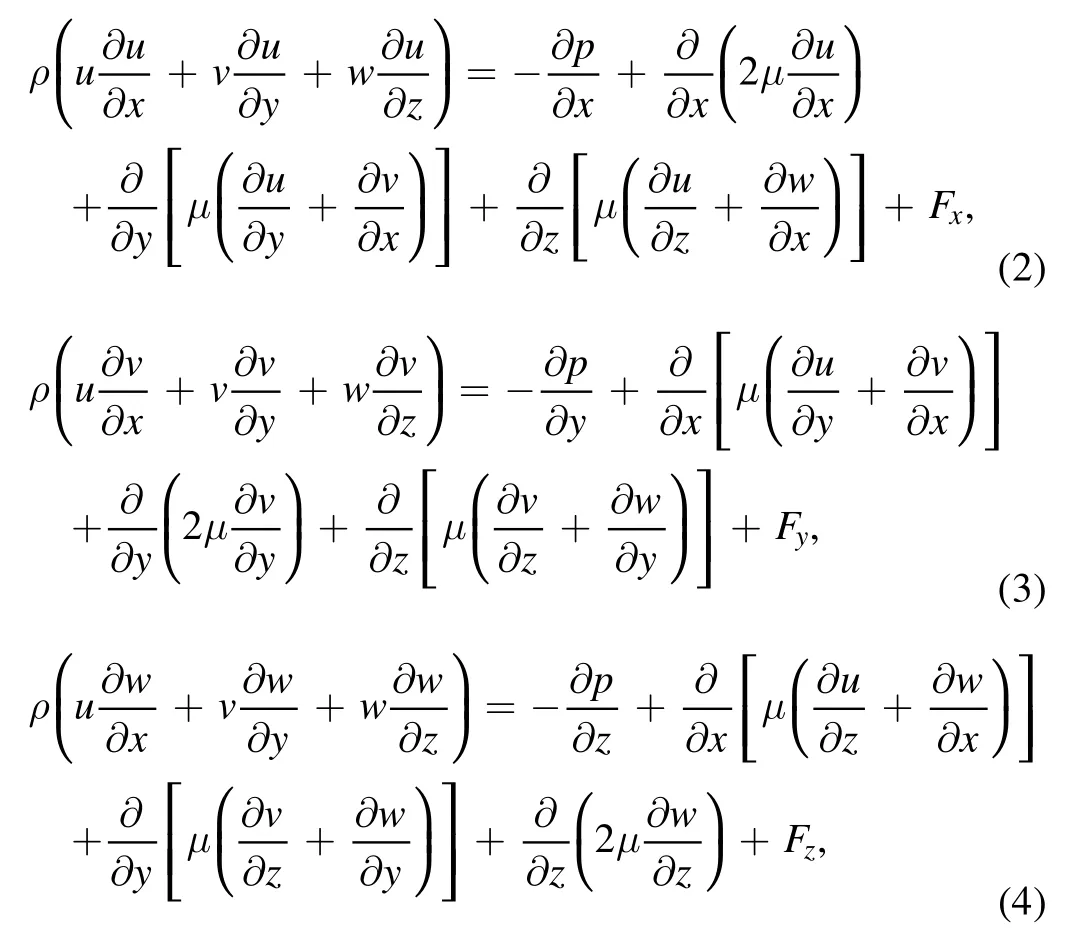
where,u,vandware the components of velocity vectorVin theX,YandZdirections,respectively.ρ,pandμare density,pressure and viscosity of helium respectively.Fx,FyandFzare the components of Lorentz forceFin theX,YandZdirections,whereF=j×B,jandBare electric current density and the magnetic induction intensity vector.
Electron energy conservation equation:
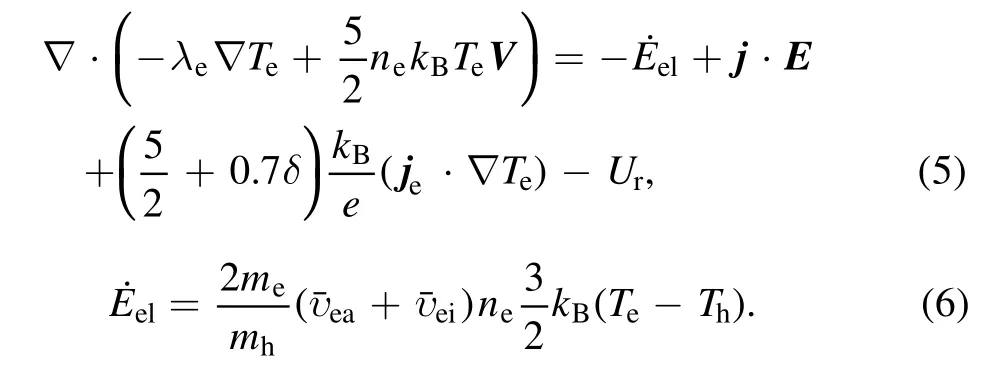
Heavy-particle energy conservation equation:

where,na,niandneare number density of neutral atoms,ions and electron,respectively.ThandTeare the temperature of heavy-particles and electrons.λhis the thermal conductivity of the heavy particles andλeis the thermal conductivity of the electrons.Eis the electric field andis the energy loss of the elastic collisions of electrons with heavy particles.0.7 ξ is a correction term,proportional to the ionization degreeξ=ne/(ni+na),which needs to be added to the electron enthalpy flow when the degree of ionization is high[30,31].

Current continuity equation:

Magnetic equation:

whereσis the electrical conductivity,the electric current densityAis the magnetic vector potential,andξ0is the magnetic permeability of free space.
In the above equations,the thermodynamic properties and the transport coefficients of two-temperature helium plasma are obtained from[32].
2.3.Computational domain and boundary condition
Figure 1 is a schematic of the six-cathode arc plasma experiment device.The arc chamber is composed of a cylinder with an inner diameter of 38 mm.By simultaneous discharge of multiple electrodes,a stable,uniform and largearea arc plasma can be obtained.The ring arranged cathode structure(tungsten with wt.2%lanthana,3 mm radius,40 mm length and a 1 mm radius at the tip plateau)is convenient to feed powder in axial direction,thereby increasing the interaction time of the plasma and the particles.The discharge image is shown in figure 2.As illustrated,the arc plasma represents a uniform,stable and diffused form,and the cathode arc root presents a complete diffused state with no contraction channel observed near the cathode tip.

Figure 1.Schematic diagram of the experimental setup.
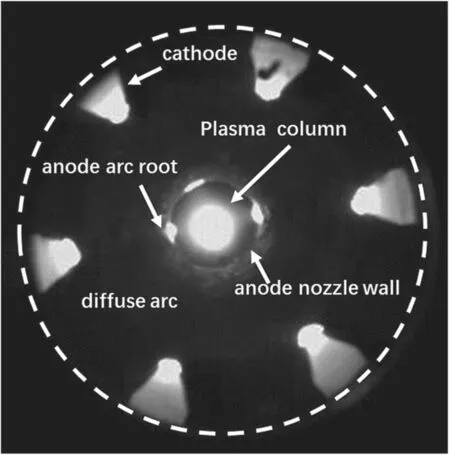
Figure 2.Window viewed image of arc discharge. I=240 A,total 1.0 Nm3 h−1,helium gas,1 μs shutter,5000 frames/s(reproduced from[13].©2017 Chinese Physical Society and IOP Publishing Ltd.All rights reserved.).
In this study,the simulations are carried out using the computational fluid dynamics software Fluent with userdefined functions in C language.The finite volume method is used to discretize the governing equation,and a simple algorithm is used to iteratively solve it.The calculation domain of plasma torch is shown in figure 3.The entire calculation domain consists of the inlet,cathode,anode,outlet and cold wall.The inner area of the computational domain has a structured grid with a grid spacing of 0.3 mm,and the boundary is an unstructured grid,which makes the flow field and temperature field inside the computational domain easier to converge,while the 3D effect caused by asymmetry is avoided.Figure 4 displays the grid on theY=0 m plane and theZ=0 m plane(the central plane of the six cathodes),respectively.It can be seen from the figure 5 that the internal mesh quality is improved and symmetrically distributed,which can reduce the fluctuation and asymmetry caused by the mesh quality.

Figure 3.Computational domain of arc plasma with six cathodes.
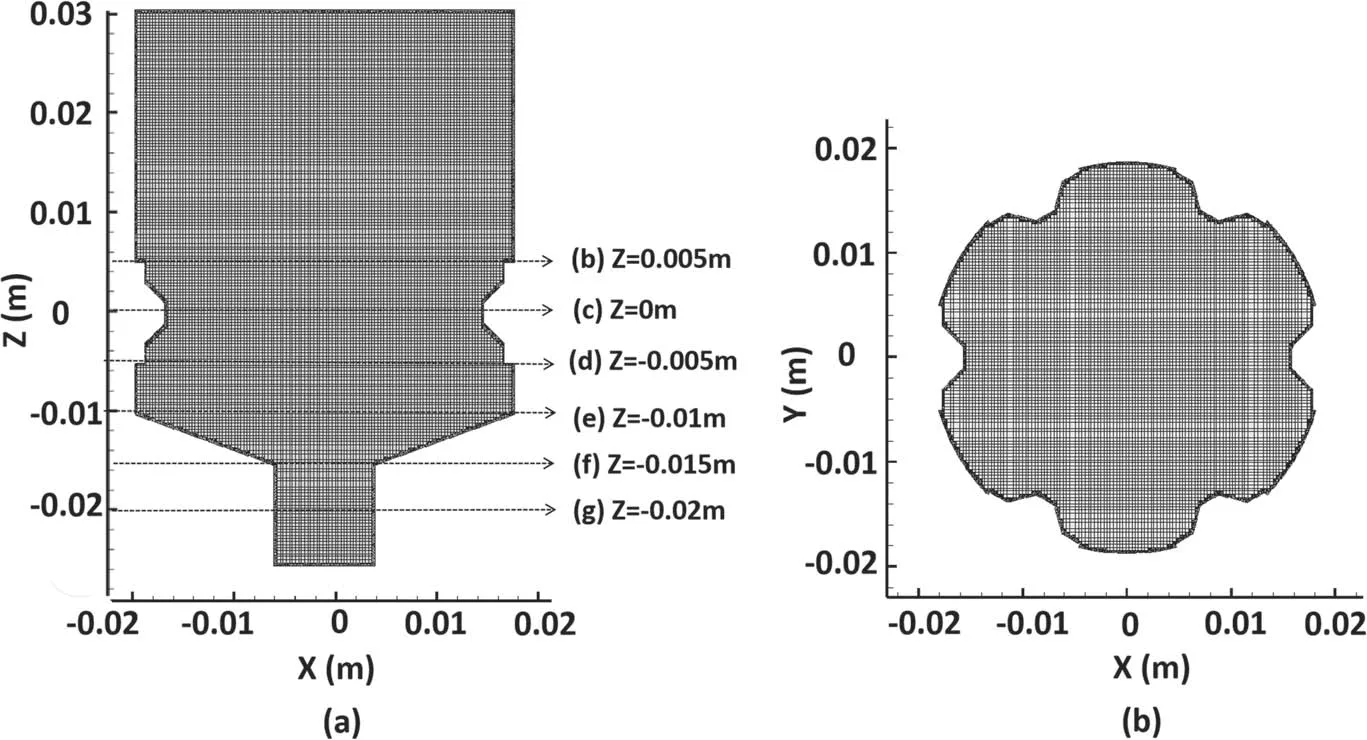
Figure 4.The computational domain and mesh for the(a) XZ(Y=0 m)plane,(b) XY(Z=0 m)plane.
The working conditions calculated in this paper are consistent with the experiment.The total current of the six cathodes is 240 A,the current flowing through each cathode is 40 A and the total inlet helium gas flow is 17 slm.The boundary conditions used in the simulation are displayed in table 1.The inlet electron temperature and the heavy particle temperature are 1000 and 300 K,respectively,and the inlet velocity is given by the gas flow rate.It should be noted that there are two inlets.One is the upper part of the device and the other is around the cathode.The ratio of the ventilation of the two gas inlets is 1:1,and both are connected to helium,which is consistent with the experiment.The cathode and anode sheaths are ignored and current density and temperature on the cathode surface are directly given.According to experimental observations,as shown in figure 2,the arc root at the cathode tip is relatively diffused[13].Therefore,we directly assume that the cathode tip current density is uniformly distributed.The shape of the cathode is a frustum.The bottom radius of the cathode is 3 mm and the radius of the cathode tip plane is about 1 mm.The given cathode current is 40 A.According to the below equation,the current density value of −1.274×107A m−2is obtained.


Table 1.Boundary conditions.
There is difference between the measured voltage and the calculated voltage.The measured value of arc voltage is about 54 V[12]and the calculated arc voltage is 37 V.In this paper,the cathode sheath is not considered.When the sheath layer is ignored,the current density distribution on the electrode surface and the electronic temperature distribution cannot be calculated coherently.Meanwhile,the voltage drop of the sheath layer is ignored,which leads to the calculated voltage being lower than the actual voltage[33,34].The aim of the present paper is to study the arc plasma distribution characteristics in the whole multi-cathode arc torch and that how the arc plasma generated by the cathodes interacts with each other.Therefore,that the cathode sheath is not considered has a weak influence on our study.
3.Results and analysis
3.1.The structure and configuration of arc plasma
Figure 5 shows isothermal surface distribution of electron and heavy particle temperatures in the non-LTE model.It can be observed that the arc column is in a contraction state near the cathode tip due to the cooling of inlet airflow and the compression of Lorentz force.In the area slightly away from the cathode,the six arc columns begin to join together to form a whole diffused arc.In this way,a stable and large-volume arc is finally formed inside the plasma generator in all directions ofX,YandZ.In the central area of the arc torch,the temperature of electrons and heavy particles is obviously higher than that of the surrounding area due to the convergence.The maximum electron temperature appears in the vicinity of the cathode and in the central region of the arc chamber,while the maximum heavy particle temperature only appears in the central region of arc chamber.This is because in the vicinity of the cathode,the current density is high,and more Joule heat is generated.Joule heat is mainly used to heat electronsj·Ein the source term of the electron energy equation),so the high-temperature zone of electron temperature appears near the cathode.In the heavy particle energy equation,the heating source term is only the energy collision term between electrons and heavy particles only.
Figure 6 shows the temperature distributions under different cross sections,which correspond to the cross sections ofZ=0 m,Y=0 m andX=0 m in the calculation domain of figure 4,respectively.It can be seen from figure 6 that in the central region of the arc chamber,the plasma is in a thermodynamic equilibrium state,and in the vicinity of the gas flow inlet and the cold wall surface,the plasma is in a non-LTE state.The heavy particle temperature is lower than the electron temperature.Figure 2 displays the window viewed image of helium arc discharge in the experiment.Comparing experimental and numerical results,the numerical temperature distribution is in good agreement with the experimental image.Furthermore,the cathode arc root displays an obvious diffusion mode,and the assumptions of our numerical simulation are in agreement with the results.

Figure 6.The temperature distributions in Y=0 m,X=0 m and Z=0 m cross sections.
Figure 7 shows the heavy particle temperature and electron temperature distributions in each section in theZdirection,where(a)–(f)of figure 7 respectively correspond to the sections in figure 4(a).It can be seen from the above figures that the arcs formed between the six cathodes and the anodes are close to each other in each section of the plasma torch.This convergence phenomenon occurs not only in the downstream(Z<0 m)region of the cathode but also in the upstream region of the cathode(Z>0 m)at the same time.Therefore,a stable,large-scale,high-temperature and diffused arc can be formed in the inside of the plasma torch in all directions.

Figure 7.The temperature distributions at different cross-sections(a)–(f).
Figure 8 shows consecutive images of the anode arc root by CCD camera in the experiment,from 200 ms to 260 ms.The arc roots can form a multiple-point distribution structure at the inlet of the anode nozzle.We can see that the helium arc in the experiment usually follows in the model of multi-point diffusion on the anode-inlet wall.Due to the limitations of the arc model,we cannot simulate the multi-point anode arc root shape.The simulated anode arc root spreads evenly on theanode wall surface as displayed in figure 9.To some extent,the numerical results are consistent with the experiment.
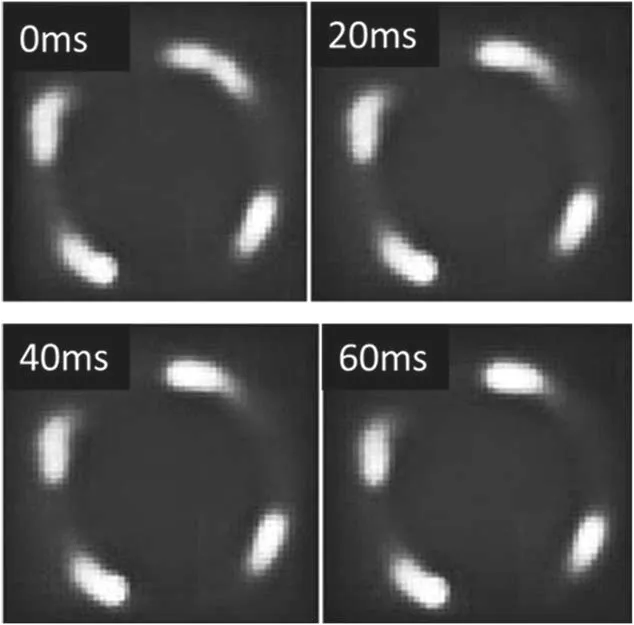
Figure 8.Consecutive images(time ms)of anode spots with a 0.5 μs shutter([12]2016 © Springer Science+Business Media New York 2016.With permission of Springer.).
In both experiments and simulation,the six cathode jets can converge to form a stable,high-temperature and diffused region.This characteristic has significant application prospects in industrial fields such as material processing and spheroidization technology.The shape and size of the high temperature zone and the velocity and temperature fields within it are important factors in heating the particulate material.Under the given gas flow and current conditions shown in figure 7,the electron temperature and heavy particle temperature in the convergence zone reach up to 12 500 K.
Figure 10 shows the excitation temperature of diffuse arc by experiment and numerical simulation.The excitation temperature of diffuse arc is determined by the Boltzmann plot method from the following equation:
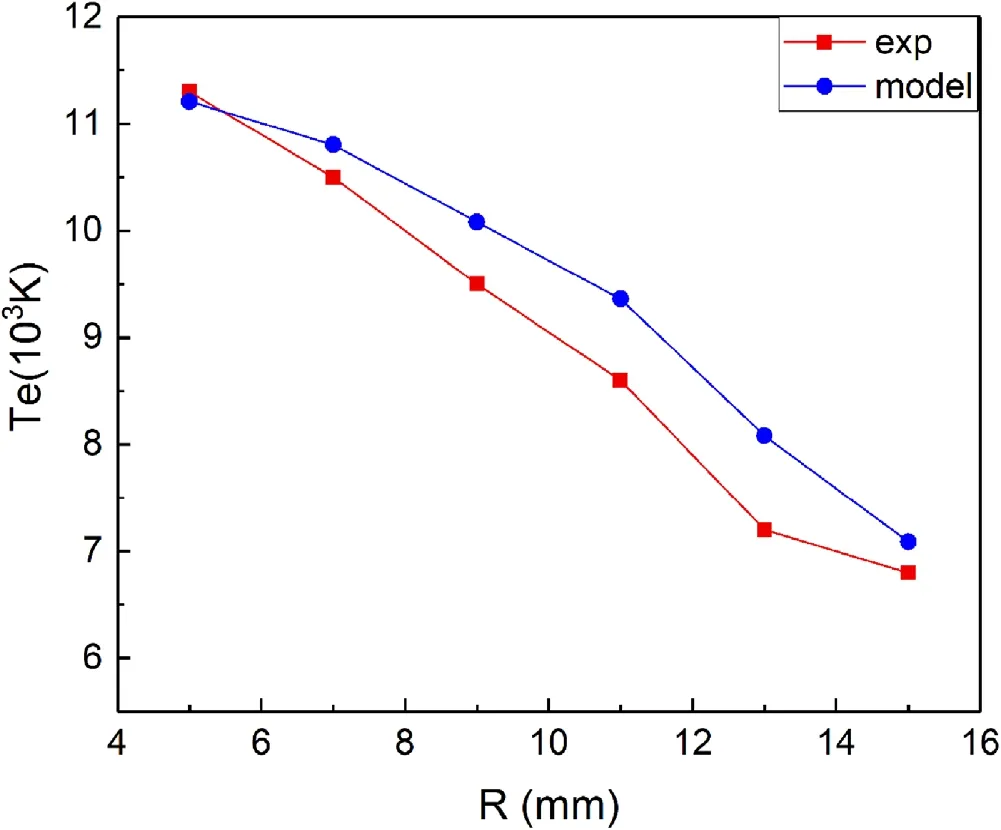
Figure 10.The electron temperature distributions in the Y direction(exp represents the experimental results,model represents the simulated results).

whereIulis the intensity of the emission line,λulis the wavelength of the transition line,Aulis the probability of the transition,guis the statistical weight of the upper level,Dis a constant,kBis the Boltzmann constant andEnis exciting energy.Seven well isolated He I lines 388.865,447.148,471.314,501.568,587.562,667.815 and 706.519 nm are used in this study.For the specified wavelength,andEnare fixed values,andcan be calculated.By plotting theversusEn,we obtain the excitation temperature from the slope of the Boltzmann fitted straight line.Since the intensity of the plasma emission line collected and transmitted by the fiber during the experiment is the result of integrating the spectral intensity along the line of sight.The calculated temperature is referred to average temperature[35].A more detailed temperature measurement process is described in our previous experimental work[13].
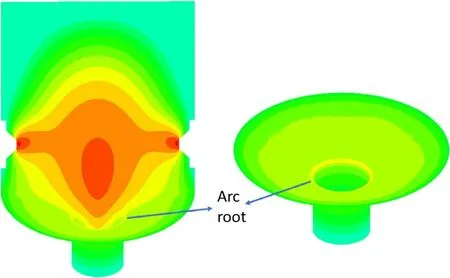
Figure 9.The anode root distribution obtained by numerical simulation.
To compare the numerical results with experimental values,the numerical electron temperature in theZdirection must be integrated.We integrate the average of the electron temperatures on theX=0 m section obtained by numerical simulation in theZdirection by equation(13):

The average electron temperatureTevain theYdirection of the arc plasma is thus determined.Figure 10 shows a comparison of numerical simulation results and experimental results.The present numerical electron temperature distribution agrees qualitatively with the measured electron temperature in the experiment.
Current density distributions onY=0 m andX=0 m cross sections are shown in figure 11.As illustrated,the current intensity represents a small-gradient and large-volume distribution between the cathodes region and converged region.The large-volume current distribution leads to a large high temperature region due to Joule heat.The current intensity distribution is consistent with temperature distribution in figure 6.

Figure 11.Current density distributions on Y=0 m and X=0 m cross sections.
Figures 12 and 13 show the current line profiles for different cross sections.The current lines start from the anode and eventually reach the six cathodes.It is worth noting that in figure 12,a large portion of the current line from the anode does not directly reach the cathode,but instead concentrates at the center of the arc torch,and then the converged current lines flow to the six cathodes,respectively.This phenomenon can also be seen in figure 13,in the cross sections(d)and(e),where the current line flows to the center of the section,and in the sections(b)and(c),where the current line flows from the center to the periphery.This is due to convergence that occurs in the central region of the arc torch during the process of the current circulating from the anode to the cathode.

Figure 12.Current line distributions on Y=0 m cross section.

Figure 13.Current line distributions on different XY cross sections.
3.2.Discussion of the mechanism of diffusion arc formation
Here,research on the formation mechanism of high-temperature diffusion regions is studied.Figures 14 and 15 show the streamline and temperature field distributions for the cross sections ofZ=0 m andY=0 m,respectively.On the plane of the six cathode centers(as shown in figure 14,Z=0 m cross section),the streamlines are not only concentrated from the cathode to the central region,but also flow to the area between two cathodes,where the vortex is generated.The high-temperature gas flowing into the area between the two cathodes increases convective heat transfer effect,which promotes the merging of the temperature fields originating from the individual cathode jets.As shown in figure 15,it can be seen that some of the streamlines that converge to the center flow downstream of the cathode and the other part flows upstream in theZdirection.The gas heated by the cathode increases the high-temperature zone in theZdirection.The convective heat transfer is helpful for the convergence of the temperature fields originating from the individual cathode jets.
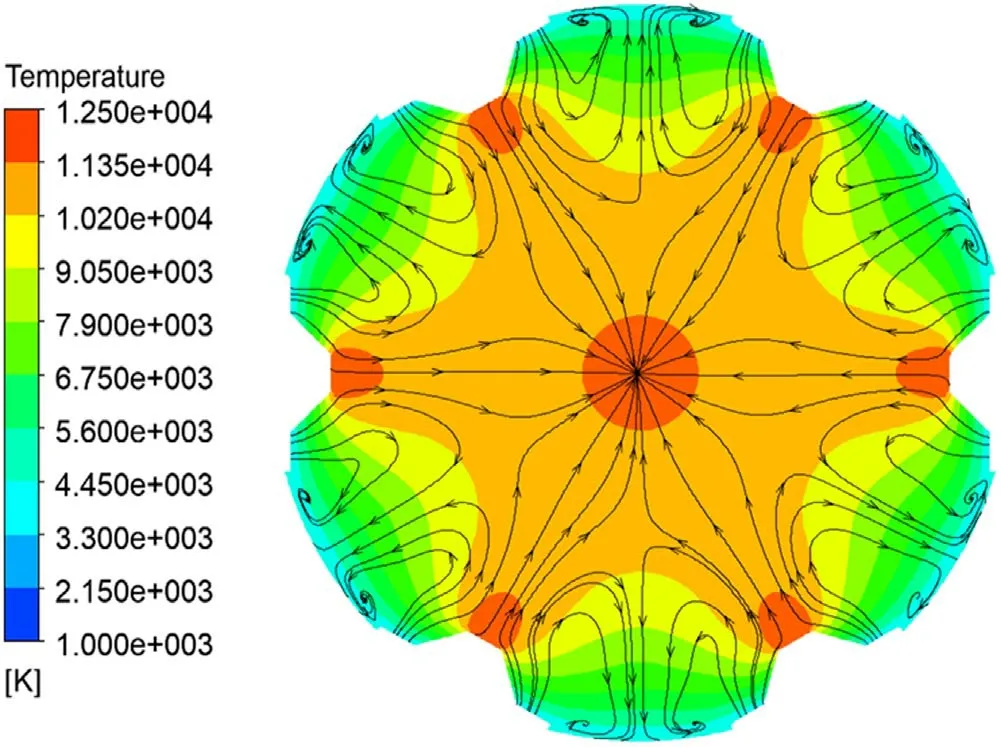
Figure 14.Streamline and temperature distributions in Z=0 m cross section.
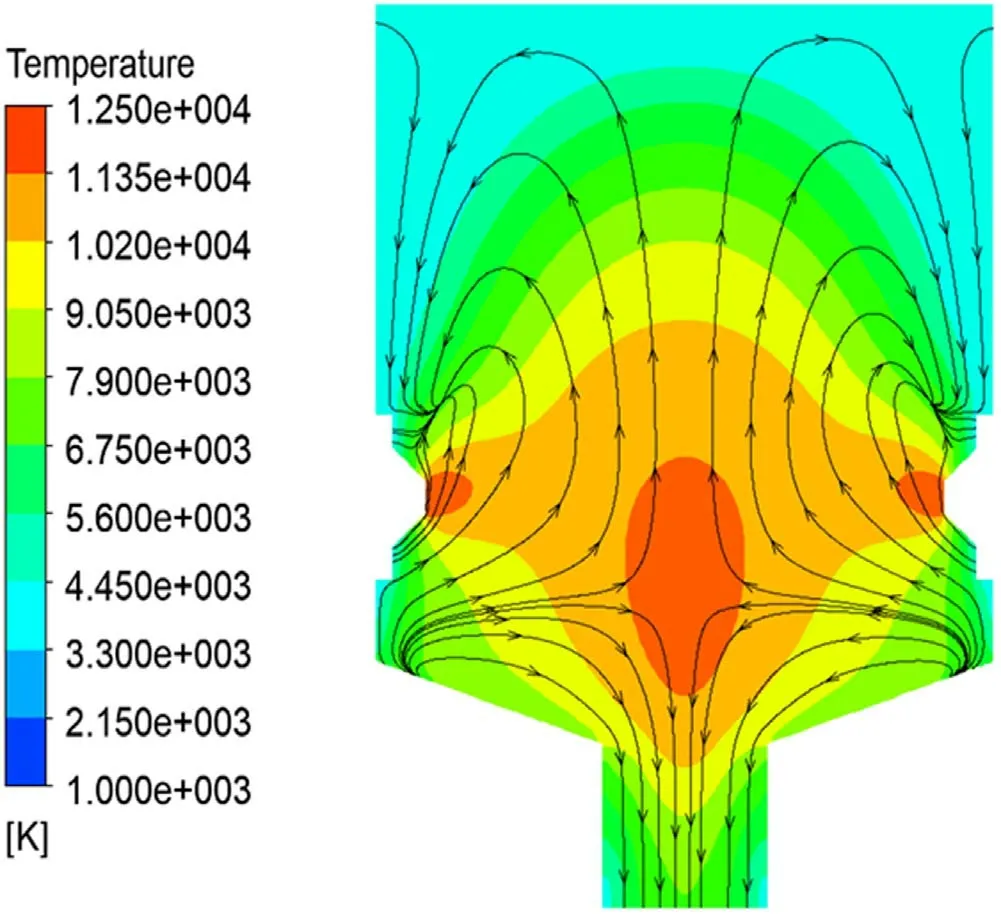
Figure 15.Streamline and temperature distributions in Y=0 m cross section.
The flow field characteristics in figures 14 and 15 can be attributed to electromagnetic effects.Figure 16 shows the Lorentz forces for the various cross-sections in theZdirection,in which(b),(c),(d)and(e)respectively correspond to the cross-sections noted in figure 5(a).Lorentz force on each arc is directed towards the central axis of the plasma torch and causes a common concentration effect for each of the six arcs.The Lorentz force is generated by an electromagnetic field,which mainly exists in the arc column channel from the cathode to the anode.Therefore,outside the arc column channel,the Lorentz force is very small.We do not show Lorentz force in the a and f cross sections.This can also be seen from the current density distribution on theY=0 m cross section,as shown in figure 17.Figure 17 displays the Lorentz force distribution over theY=0 m cross section.The strong Lorentz force generated near the cathodes is directed towards the upstream of the cathode and a portion is directed towards the downstream of the cathode.This results in convective heat transfer from the vicinity of the cathode to upstream and downstream of the cathode(figure 15).However,because the current path mainly exists in the region downstream of the cathode to the anode(as shown in figure 12),the Lorentz force near the cathode downstream is stronger than the force upstream,which causes the gas near the cathode to flow upstream,strengthening convective heat transfer in the cathode upstream,so there is also a convergence of high temperature areas upstream of the cathode,as shown in figure 6(a).
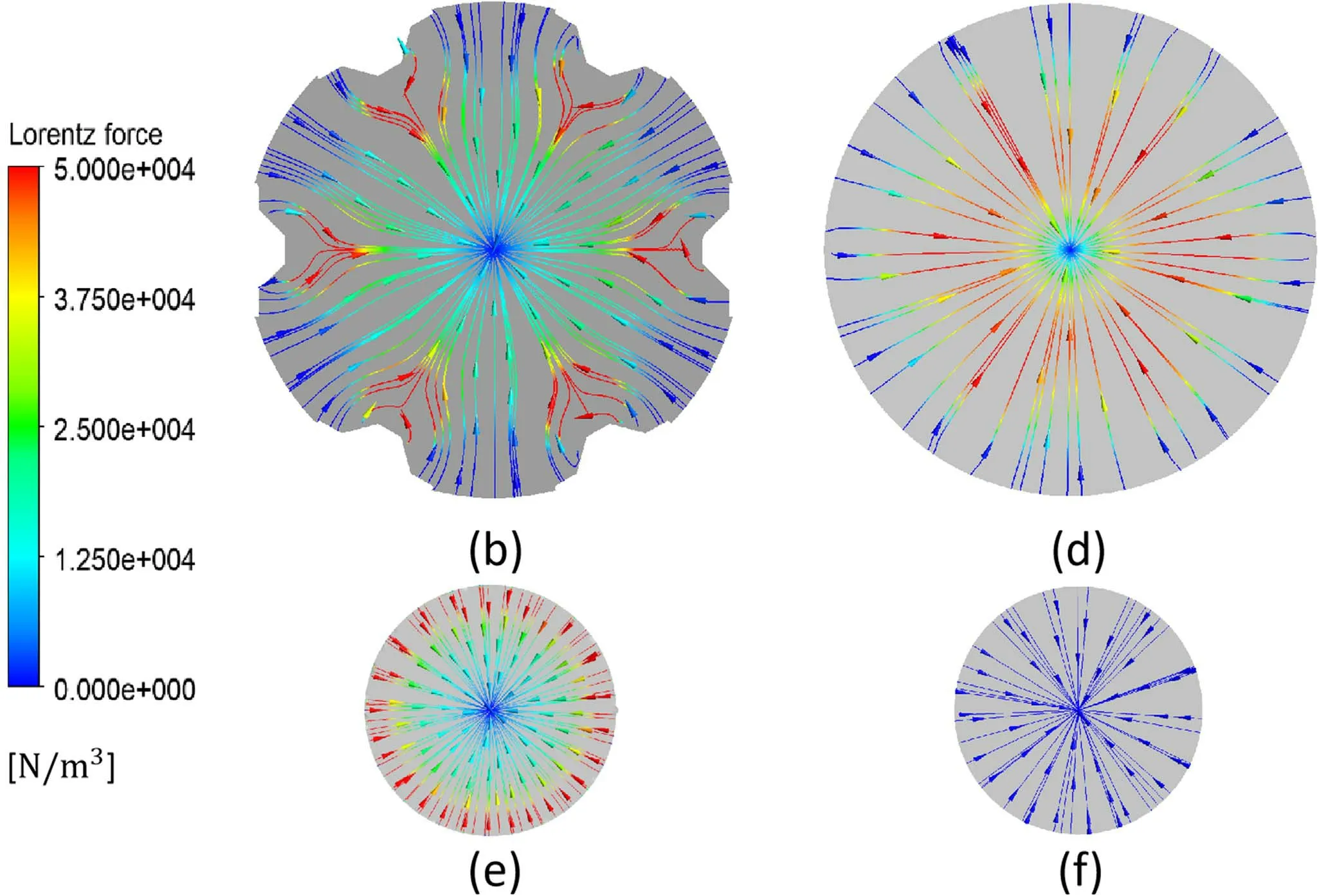
Figure 16.Lorentz force distributions in different cross sections.
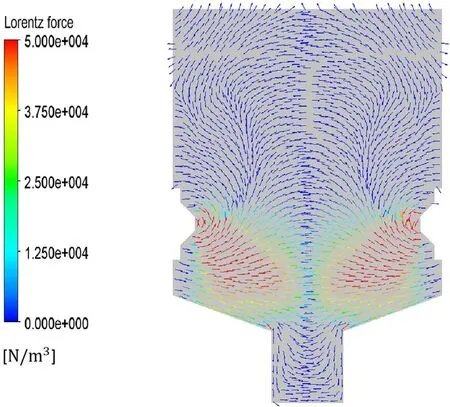
Figure 17.Lorentz force distributions in Y=0 m cross section.
Figures 18 and 19 display the flow field and streamline distribution for different cross sections,respectively.The flow field reveals that when gas flows from the inlet around the cathode into the interior of the multi-cathode plasma torch,eddy currents are formed between the two cathodes to allow the gas to fill the space near the inlet region which enhances the heat transfer of adjacent arc columns,further leading to the convergence of the six arcs.This process is shown in figures 14,18 and 19(b).Meanwhile,it can be seen from figure 19 that there is a low-velocity region in the downstream region of the intersection of the six arcs.This region is hardly affected by the convective heat transfer of the arc,but the electron and heavy particle temperatures in this region are very high.We can look to the current density distribution for the cause.Figure 11 shows that this low-velocity region is the exact intersection zone of the current channels,which indicates that the high-temperature region is mainly caused by the Joule heat of the arc.The above analysis results suggested that the large-volume high-temperature diffusion arc plasma inside the six-cathode plasma torch is the result of the combined action of convective heat transfer(figures 14 and 15)and Joule heat(figure 11).The diffused distribution of current plays an important role,followed by convection heat transfer.

Figure 18.Velocity field and streamline distributions in Z=0 m cross section.

Figure 19.Velocity field and streamline distributions in(a) Y=0 m and(b) X=0 m cross sections.
4.Conclusion
In this paper,the 3D two-temperature steady arc model was used to predict the temperature field,flow field and electromagnetic field distribution inside a multi-cathode plasma torch,and the formation mechanism of the large area hightemperature diffusion arc inside the plasma torch was analyzed.The simulated results were compared with the experimental results.In the case where the total current of the six cathodes was 240 A and the total intake flow rate was 1Nm3h-1,the numerical simulation results showed that:
(1)Six cathode jets converge in the central region of arc chamber to form a high temperature diffusion arc in which the maximum electron temperature appears near the cathode and in the central converging region,while the maximum heavy particle temperature only appears in the central converging region.This phenomenon is in good agreement with the observed arc image in the experiment.
(2)Near the cathode tip,due to the cooling of the inlet airflow and the compression of the Lorentz force,the arc column is in a contracted state.Slightly away from the cathode,the six arc columns begin to form a large area high temperature diffusion arc.In the center of the plasma torch,due to the convergence,the electron temperature and heavy particle temperature are significantly higher than in the surrounding area.Eventually,the interior of the plasma torch forms a stable large-scale high-temperature diffusion arc in all directions ofX,YandZ.At the same time,the calculated electron temperature distribution is in good agreement with the measured electron temperature in the experiment.
(3)The arcs formed between the six cathodes and the anode are close to each other in each section of the plasma torch.This convergence phenomenon occurs not only in the downstream of the cathode but also in the upstream region of the cathode due to the Lorentz force promoting the flow field in the upstream and downstream convergence of the cathode.In each cross section in theZdirection,the Lorentz force on each arc is directed towards the central axis of the plasma torch and produces a common concentration effect for each of the six arcs.
(4)The large-area,high-temperature and diffused arc inside the multi-cathode arc torch is a combined effect of Lorentz force,convection heat transfer and heat conduction.
Acknowledgments
The work is supported by National Natural Science Foundation of China(Nos.11875256,12005023,11705202),Scientific Research Fund Project of Anhui Jianzhu University(No.2020QDZ09)and Anhui Provincial Natural Science Foundation(No.1808085MA12).
ORCID iDs
猜你喜欢
杂志排行
Plasma Science and Technology的其它文章
- Numerical simulation of carbon arc discharge for graphene synthesis without catalyst
- Enhanced removal of ultrafine particles from kerosene combustion using a dielectric barrier discharge reactor packed with porous alumina balls
- Visualization of gold nanoparticles formation in DC plasma-liquid systems
- Rice plant growth and yield:foliar application of plasma activated water
- An active tunable Fano switch in a plasmafilled superlattice array
- Comparison of sample temperature effect on femtosecond and nanosecond laser-induced breakdown spectroscopy
